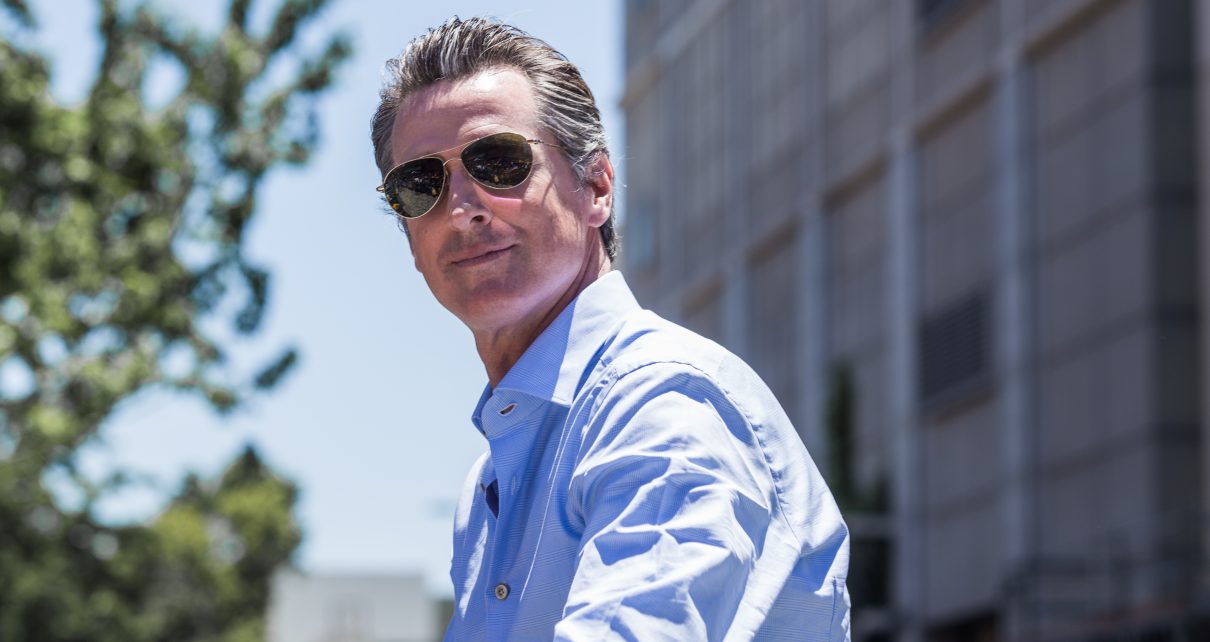
California Governor Gavin Newsom (then Lieutenant Governor) riding in the Golden State Warriors Parade in Oakland, CA, Jun. 12, 2018. (Photo: Amir Aziz/Shutterstock)
State ZEV Truck Sales Goals Are Two Years Ahead Of Schedule According To New CARB Data
Experts warn that many issues could slow down ZEV adoption in the coming years
By Evan Symon, October 24, 2023 12:08 pm
The California Air Resources Board (CARB) and Governor Gavin Newsom’s office announced on Monday that the state’s zero-emissions vehicle (ZEV) goal for trucks was two years ahead of schedule, with 7.5% of all new trucks sold in California in 2022 being ZEV.
State mandates to quickly increase ZEVs by outlawing the sale of new gasoline and diesel powered vehicles in the coming decades have been in place in California since the beginning of the decade. In 2020, Governor Newsom signed an executive order, later backed by CARB, to ban the sale of new gas powered passenger vehicles by 2035. Trucks were next on the agenda, with CARB announcing later that year a new “advanced clean trucks” rule, stating that the number of new zero emission electric trucks would increase each year beginning in 2024. By 2035, the rule would have 40% of tractor trailers, 55% of pickup trucks, and 75% of delivery vans be zero emission. All government-owned trucks would also need to be electric by 2035.
Every car company in California will also have to have an electric or hydrogen-powered option by 2024, with CARB currently aiming for net-zero emissions in California by 2050. Under these rules, the share of total electric trucks would go from under 1% in 2020 to at least 15% by 2045, with all new trucks sold in California being zero-emission by 2045.
CARB and the Truck and Engine Manufacturers Association (EMA) also agreed to the “advanced clean fleets” rule earlier this year. Under this regulation, all new diesel big rig trucks and buses will be banned in the state of California starting in 2036, with all trucks in California needing to be zero-emissions by 2042. CARB also aims to achieve a total zero-emissions truck and bus fleet by 2045, as well as have at least 1.6 million zero-emission medium- and heavy-duty trucks operating in the state by 2048.
While concerns about charging and battery life in the new cars has kept many consumers away until technology and charging times for cars becomes closer to gasoline-filling times at the pumps, Californian motorists nonetheless have been exceeding sales expectations. In April of this year, the state hit the 1.5 million zero emission vehicles (ZEVs) sales mark two years earlier than the original 2025 goal. And on Monday it was announced that the ZEV truck sales goal was also two years ahead of schedule. The goal – 6% of new trucks sold in California to be ZEV by 2024 – was exceeded by 1.5% in 2022, with 7,639 ZEV trucks sold. With a 50% ZEV mark looming for 2035 new truck sales, the quicker than expected adaption came as something of a surprise to both CARB officials and Governor Newsom this week.
“We’re cleaning up California’s air by getting more clean vehicles on the road, and we’re doing it years ahead of schedule,” said Governor Newsom in a statement. “Californians will keep seeing this progress in real time, with big rigs and other heavy-duty trucks on our roads going clean. We’ve provided the incentives, goals, and infrastructure to get us here and continue this progress for decades to come.”
Despite the better than expected figures, experts told the Globe on Tuesday that the next few years of sales would be critical to map out if adoption of electric cars would really be on track, with new technology, the end of COVID-19 restrictions, the rising popularity of hybrid models, auto strikes, and other factors all playing a role.
Truck ZEV sales goals ahead by two years
“This is encouraging news for California, but it is a bit too early to celebrate,” said transportation advisor Danny Guzman. “Ask anyone in the auto industry, and they’ll say that electric cars are the future. And that’s great from an oil importation perspective, an ecological perspective, an economic perspective, and more. But the state is really overestimating adoption. They may be ahead of schedule right now, but there are a lot of indicators that this will slow down.
“First of all, COVID is over. There were huge waits on ZEVs and hybrids in the past few years due to people saving up for them. But now people aren’t buying them as much. Sales are dropping, and many dealers have a ton of them on their lots. For California’s high adoption rate and the gas-powered sales ban to really make sense, we need to see higher nationwide adoption, especially with more charging stations. This is hurting that. cars and trucks alike will need a network of charging stations for interstate travel, as well as a network of at-home charging stations. California is well on their way to doing that, but most other states are nowhere near where they should be. People aren’t seeing many and are simply going back to gas and hybrids.
“If a battery comes out with an under 5 minute charging time, similar to filling a tank of gas, the lack of charging stations could be more readily excused, but right now the best times are 30 minutes to an hour from zero to a full charge. And that’s the best. Most others take hours more. And that only makes sense if you can get the right hookups at home or at an apartment complex, with both presenting major challenges.
“And let’s not forget the unions. The UAW absolutely hates electric vehicles because battery and electric car plants employ far fewer workers than traditional engine and car plants. The majority of electric car plants are also non-unionized, so if the switch-over happens as quickly as California wants it too, the UAW could be in even worse shape than they are now. They aren’t outright saying it, but I know from some of their guys that they hate these Californian 2035/2045 regulations. They also don’t like the fact that Tesla is non-union, but that’s another story.
“There’s a lot more factors here. I didn’t even get into how hybrids are infinitely more popular than electric options and that California is ignoring those as a transitionary option. And I didn’t go into how [Governor Newsom] is getting uncomfortably close to Chinese electric car people. But there isn’t that much to celebrate with electric being a few years ahead. There’s still a ton of problems and plenty of hurdles that could just knacker this. There are scenarios where the state decides to end the end by dates because so much goes wrong.
“Being ahead of schedule is fine – the way things are looking, they may need that head start.”
More figures on California’s ZEV goals are due soon.
- Bill to Require Law Enforcement Disclosure if AI Was Used To Help Write Reports - August 7, 2025
- Gov. Newsom Files FOIA Request To ‘Expose True Cost’ Of L.A. Federal Troop Deployment for Anti-ICE Riots - August 6, 2025
- California Redistricting: How Newsom’s Plan Will Demolish Hard Fought GOP Gains - August 6, 2025





Let’s all celebrate. The low hanging fruit has been picked. (roll eyes)
Prediction. Sales will collapse when trucking firms find out they are totally unstainable economically and practically.
exactly
Fingers crossed for that prediction to come true.
just wait – they will end up in the same trash heap that the electric busses the government has been purchased and the company Proterra filed bankruptcy.
Solyndra Part II – what’s a few $100M of tax payer money here and there and lost